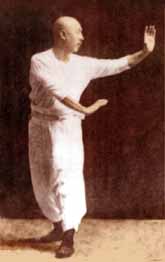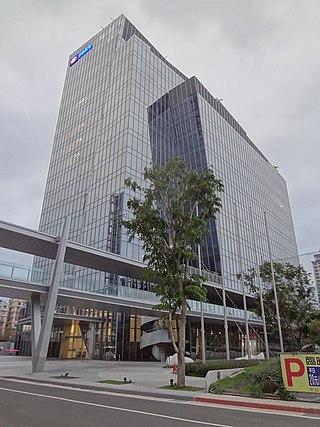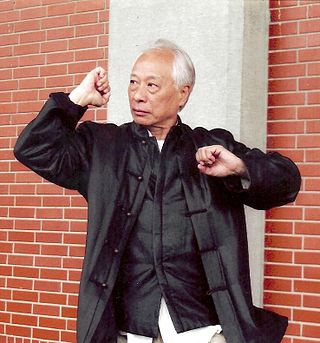
Baguazhang is one of the three main Chinese martial arts of the Wudang school, the other two being tai chi and xingyiquan. It is more broadly grouped as an internal practice. Baguazhang literally means "eight trigram palm", referring to the bagua "trigrams" of the I Ching, one of the canons of Taoism.

Chang Po-ya is a Taiwanese politician who is the founder of the Non-Partisan Solidarity Union, a political party in Taiwan.

Kiku Chen Chu is a Taiwanese politician serving as president of the Control Yuan and chairwomen of the National Human Rights Commission since 2020. Before assuming her current post, Chen had served as Secretary-General to the President from 2018 to 2020 and Mayor of Kaohsiung from 2006 to 2018, making her the longest-serving mayor of the city since the Japanese occupation of Taiwan.

The Generals of the Yang Family is a collection of Chinese folklore, plays and novels on a military family from the earlier years of imperial China's Song Dynasty (960–1279). The stories recount the unflinching loyalty and the remarkable bravery of the Yangs as they sacrificed themselves to defend their country from foreign military powers, namely the Khitan-ruled Liao Dynasty (907–1125) and Tangut-ruled Western Xia (1038–1227).

Kaohsiung Main Station is a railway and metro station in Sanmin District, Kaohsiung, Taiwan served by the Taiwan Railways and Kaohsiung Rapid Transit. It is one of four special class stations, the highest class with the most services. It is currently undergoing reconstruction, scheduled to be complete in 2024.

The Jingnan campaign, or Jingnan rebellion, was a three-year civil war from 1399 to 1402 in the early years of the Ming dynasty of China. It occurred between two descendants of the Ming dynasty's founder Zhu Yuanzhang: his grandson Zhu Yunwen by his first son, and Zhu Yuanzhang's fourth son Zhu Di, Prince of Yan. Though Zhu Yunwen had been the chosen crown prince of Zhu Yuanzhang and been made emperor upon the death of his grandfather in 1398, friction began immediately after Yuanzhang's death. Zhu Yunwen began arresting Zhu Yuanzhang's other sons immediately, seeking to decrease their threat. But within a year open military conflict began, and the war continued until the forces of the Prince of Yan captured the imperial capital Nanjing. The fall of Nanjing was followed by the demise of the Jianwen Emperor, Zhu Yunwen. Zhu Di was then crowned the Ming Dynasty's third emperor, the Yongle Emperor.

Hwang Yau-tai or Huang Yau-tai was a Chinese musician, writer and composer. He wrote over 2000 compositions, the most popular being "Azaleas," which was written in 1941 during the Second Sino-Japanese War.

Jess Lee Kar Wei, is a Chinese Malaysian singer.

PX Mart is a supermarket chain in Taiwan. As of October 2021, PX Mart operates 1,056 stores across the island, making it the largest supermarket chain in Taiwan and the second largest retailer by revenue behind 7-Eleven. The corporate headquarters is located in Zhongshan District, Taipei.

Chao Chuan, known sometimes as "Chief" Chao, is a Taiwanese pop singer.
The architecture of Taiwan can be traced back to stilt housing of the aborigines in prehistoric times; to the building of fortresses and churches in the north and south used to colonize and convert the inhabitants during the Dutch and Spanish period; the Tungning period when Taiwan was a base of anti-Qing sentiment and Minnan-style architecture was introduced; in Qing dynasty period, a mix of Chinese and Western architecture appeared and artillery battery flourished during Qing's Self-Strengthening Movement; During the Japanese rule of Taiwan, the Minnan, Japanese and Western culture were main influencers in architectural designs and saw the introduction and use of reinforced concrete. Due to excessive Westernization as a colony, after the retrocession of Taiwan to the Republic of China in 1945 from Japan at the end of World War II, Chinese classical style became popular and entered into international mainstream as a postmodern design style. Today, Taiwanese architecture has undergone much diversification, every style of architecture can be seen.

Jiang is a Chinese surname, accounting for 0.26% of the Han Chinese population. It is the 52nd most common Chinese surname and is the 141st surname listed in the Hundred Family Surnames poem, contained in the line 江童顏郭. It is the 75th most common surname in China (2007), and the 25th most common surname in Taiwan (2010).
Hsin-Chien Huang is an artist and director working in mixed media. Science, technology, new media, programming, and algorithms are tools he uses to bring the universe of his imagination to life. He served as artistic director for SEGA and Sony. Huang collaborated with pioneering American media artist Laurie Anderson on their VR work La Camera Insabbiata/Chalkroom which won the Best VR experience Award at the 74th Venice International Film Festival(it was the first edition of the festival that introduced its virtual-reality section); he also designed her 1995 CD-ROM, Puppet Motel. His work Bodyless was also nominated in the 76th of the festival. In 2011,Huang received the "Pride of Taiwan" honor from president of Taiwan Ma Ying-jeou.

Hsu, Chi, commonly known as Adam Hsu is a martial artist and essayist known for his expertise in various forms of Chinese martial arts. Hsu was born in mainland China in 1941 and later moved to Taiwan, where he has operated for most of his life.

USS LST-755 was a LST-542-class tank landing ship in the United States Navy during World War II. She was transferred to the Republic of China Navy as ROCS Chung Hai (LST-201).
Parade formations, also known as "Tīn-thâu" in Taiwanese Hokkien or "Zhen Tou" in Mandarin (陣頭), are a traditional folk art originating from China. As a part of worship activities and temple festivals, members of communities express gratitude to the gods by escorting them in a procession. This practice can be either performed while walking or in fixed locations along the streets, incorporating elements of acrobatics and folk dramas. The term “Zhen Tou” came from coastal regions like Fuzhou and Minnan in China. The folk art has flourished in Taiwan, particularly in the southern regions where the highest number and variety of Zhen Tou can be found.
The Soul Guiding Array, also known as “khan-bông kua-tīn” in Taiwanese, is a form of parade formations unique in Taiwan, commonly performed during funeral ceremonies. It is prevalent in the regions south to the Zhuoshui River. The ensemble of Soul Guiding Array typically consists of five to seven members. The musicians and ritual masters are usually male, while the rest of the roles are portrayed by females. The performance happens around the incense pavilion, with the performers holding magical tools and engaging in recitation, singing, dancing, and various ritualistic acts like guiding souls, consoling the deceased, opening paths, and sending spirits peacefully to the afterlife. These performances reflect the prevailing folk beliefs in Taiwan, including “immortal souls,” “judgment after death,” and “karma and reincarnation.”
Taipei Daojiang Ling An She, also known as Taipei Ling An She, was established in 1871. It is a longstanding beiguan “titzu hsuanshe” in the Taipei area. They own several ancient “shen chiang”, human-sized costumes of deities that can be worn by people during parade formations and they are dedicated to promoting beiguan and “Chen Tou” culture. In 2015, it received the 19th Taipei Culture Award. In 2022, the shen chiang, including the Hsieh and Fan Generals, the literary and martial generals, the Xiahai City God, and the Xiqin Wangye preserved by the troupe were designated as general historical relics of Taipei City.
"Mom, Take Care of Yourself!", or "Mama, Please Take Care" is a cover of the 1957 Japanese song "Though We Came to Tokyo"(Japanese: 俺らは東京へ來たけれど), originally composed by Shinichi Nozaki (野崎真一), with lyrics by Takashi Kojima (小島高志), and originally sung by Hideo Fujishima (藤島桓夫). The song was originally composed by Shinichi Nozaki, lyrics by Takashi Kojima, and originally sung by Huanfu Fujishima, and lyrics were written by Taiwanese musician Wen Hsia in 1959, describing the sadness of a young man from a rural village who leaves his home to fight for his life in the city, and his mother's heart when he is in a foreign land.












